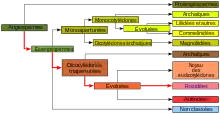Tapisciaceae
Les Tapisciacées sont une famille de plantes dicotylédones contenant deux genres.

Voir le texte pour plus d'information.

Ce sont des petits arbres à feuilles alternes, stipulées, originaires des régions subtropicales et tropicales des Antilles et d’Amérique du Sud (Huertea), et de Chine (Tapiscia).
Étymologie
Le nom vient du genre type Tapiscia, une anagramme de Pistacia (Anacardiaceae), genre avec lequel le botaniste britannique Daniel Oliver trouva quelques similitudes[1] - [2].
Classification
En classification classique de Cronquist (1981)[3], cette famille n'existe pas.
En classification phylogénétique APG II (2003)[4] la famille est placé dans les Malvidées (Eurosidées II).
Le Angiosperm Phylogeny Website [18 Avr 2007] place cette famille dans l'ordre Huerteales, choix qui a été confirmée par la classification phylogénétique APG III (2009)[5].
Liste des genres
Selon NCBI (15 juin 2010)[6] :
- genre Tapiscia (en) Oliver
(NCBI (15 juin 2010)[6] place Huertea dans Crossosomatales → Staphyleaceae)
Selon Angiosperm Phylogeny Website (15 juin 2010)[7], GRIN (15 juin 2010)[8] et DELTA Angio (15 juin 2010)[9] :
- genre Huertea Ruíz & Pavón
- genre Tapiscia Oliver
Liste des espèces
Selon NCBI (15 juin 2010)[6] :
- genreTapiscia
- Tapiscia sinensis
Selon GRIN (15 juin 2010)[8] :
- genre Huertea Ruiz & Pav.
- Huertea cubensis Griseb.
- genre Tapiscia Oliv.
- Tapiscia sinensis Oliv.
Notes et références
- (en) Maarten J M Christenhusz, Michael F Fay et Mark W. Chase, Plants of the World : An Illustrated Encyclopedia of Vascular Plants, Chicago, The University of Chicago Press, , 792 p. (ISBN 978-0-2265-2292-0, lire en ligne), p. 384
- Revue Horticole, Paris, 1891, p. 30
- (en) Arthur Cronquist, An Integrated System of Classification of Flowering Plants, New York, Columbia University Press, (ISBN 0-231-03880-1, OCLC 1136076363, lire en ligne)
- (en) Angiosperm Phylogeny Group, « An update of the Angiosperm Phylogeny Group classification for the orders and families of flowering plants: APG II », Botanical Journal of the Linnean Society, Wiley-Blackwell, Linnean Society of London et OUP, vol. 141, no 4, , p. 399–436 (ISSN 0024-4074 et 1095-8339, DOI 10.1046/J.1095-8339.2003.T01-1-00158.X)
- (en) Angiosperm Phylogeny Group, « An update of the Angiosperm Phylogeny Group classification for the orders and families of flowering plants: APG III », Botanical Journal of the Linnean Society, Wiley-Blackwell, Linnean Society of London et OUP, vol. 161, no 2, , p. 105–121 (ISSN 0024-4074 et 1095-8339, DOI 10.1111/J.1095-8339.2009.00996.X)
- NCBI, consulté le 15 juin 2010
- Stevens, P. F. (2001 onwards). Angiosperm Phylogeny Website. Version 14, July 2017 [and more or less continuously updated since]." will do. http://www.mobot.org/MOBOT/research/APweb/, consulté le 15 juin 2010
- USDA, Agricultural Research Service, National Plant Germplasm System. Germplasm Resources Information Network (GRIN-Taxonomy). National Germplasm Resources Laboratory, Beltsville, Maryland., consulté le 15 juin 2010
- DELTA Angio, consulté le 15 juin 2010
Liens externes
- (en) Référence Flora of China : Tapisciaceae
- (en) Référence Angiosperm Phylogeny Website : Tapisciaceae ()
- (en) Référence DELTA Angio : Tapisciaceae (F. Pax) Takhtajan
- (en) Référence NCBI : Tapisciaceae (taxons inclus)
- (en) Référence GRIN : famille Tapisciaceae Takht. (+liste des genres contenant des synonymes)